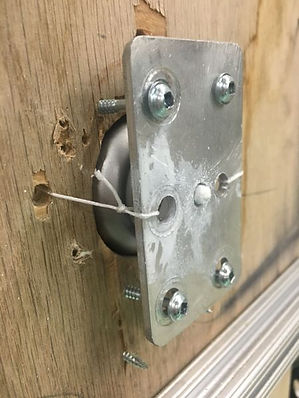AUTONOMOUS FIELD PAINTER

In my senior year of high school, I took a capstone design class called Engineering Design and Development. Working in a team of two over the course of one year, we went through the process of developing a product, from brainstorming to benchmark tests of a functional prototype.
DEFINING THE PROBLEM
Sports fields are striped by hand, which is both time-consuming and inaccurate. The process takes around 16-20 hours and still results in crooked, inaccurate lines.
DESIGN CRITERIA
What must the product be able to do?
The product must be reliable and not prone to malfunctions, which cost the employees time to fix. This product must also be able to assist or guide the user in keeping lines straight, which is defined as one inch tolerance on either side of a perfectly straight line four inches wide. This tolerance was derived from interviews with Mankato East's Athletic Director.
What does the customer want/need?
The customer wants a reliable process to paint straight lines. We have defined "straight" lines as staying within one inch on either side of a perfectly straight line 4 inches wide.
Identify considerations for the ergonomics of the product.
The product must be easy to set up and use. It should not require any more work to set up than current painting methods (setting up poles at each end and running a cable between the poles).
What size should the product be, or what restrictions to size exist? What are the weight restrictions on this product?
The product should be around the size of an average push painter, which is +/- 5 inches from 40 x 24 x 36 inches. The weight should not exceed 150 pounds, which would make the product hard to handle and difficult to move around.
If the product is autonomous, weight would not be as much of an issue.
Who is the target consumer?
The target consumers for this product are grounds crews who paint football and soccer fields for college, high school, and youth programs.
What is the anticipated cost to the consumer for this product?
The target cost for the product would be somewhere around $2,000.
CONSTRAINTS
-
only supplies are shop tools and parts from an old FIRST Robotics competition robot
-
project must be completed in less than 8 months
-
50 minutes of work/day
BRAINSTORMING SOLUTIONS
In our first brainstorming session, we created 50 potential solutions over the course of several days.

PRELIMINARY SKETCHES
We went through our 50 brainstormed ideas and selected the four ideas we thought were the most viable. Next, we developed preliminary sketches of each to evaluate and choose from.


1. a push painter that follows a cable along the ground
2. an autonomous painter that uses a GPS system to navigate
3. an autonomous painter that follows a laser beam
4. a push painter with lasers indicating where paint will go
EVALUATING POTENTIAL SOLUTIONS

FINAL SKETCH
We decided the final product would be powered by a rechargeable battery (not pictured). The wheels are driven by a chain-and-sprocket system, tank-drive style. We decided that due to our current time restraints, we will use a disposable aerosol paint can for painting, rather than a complex painting system. If we decided to continue with this project after the prototyping and testing phase, we would likely try to incorporate an industry-standard painting system.

FINAL RENDERING

PROTOTYPE CONSTRUCTION
Using our available supplies, we constructed and programmed a working prototype of our autonomous laser-following robot.





PAINTING MECHANISM
The metal plate is held in in place by the corner bolts, but is free to move up and down. When it is pulled up by the cords, the plate presses against the can's spray nozzle and releases paint.
SAFETY
This ultrasonic sensor stops the robot instantly if it detects anything in its path. Additionally, the robot will stop moving if the laser's path is broken at any point.

TESTING THE PROTOTYPE


Due to the slow speed recorded in the first test, we adjusted the max speed of the robot in the code and re-tested.
This time, we exceeded our target speed of 3 mph.

Next, we tested the robot's ability to paint a straight line autonomously. Our benchmark for this test was ±1" on either side of a perfectly straight line. For the first two tests, the maximum painted distance from a perfectly straight line was 0.5", well within our criteria.

REFLECTIONS
BRAINSTORMING
We did a fair job at brainstorming solutions, but it would’ve been helpful to divide some parts up into sections, like ideas for a spraying mechanism, ideas for how to follow a line, etc.
EVALUATING SOLUTIONS
This step went fairly smoothly, but also would’ve been improved if we had split each design up into parts and voted on each. There were some good parts of each design idea, so it would’ve been better to vote on separate parts of the solution separately.
CONSTRUCTION
Our construction process went well, but the final solution would’ve been more aesthetically pleasing if we would've had more funds to purchase materials. Since our painter was retrofitted from a competitive robotics program’s old robot, we were limited in our design options.
OVERALL
We feel our design process went fairly smoothly. Although it would've been advantageous to split up the brainstorming and design choosing steps so we could decide on each aspect of the design, instead of on one final design, it was not a major setback. The biggest issue we encountered was lack of time. Our project was a lot to tackle, and we should've decided earlier on to not use a complex painting system instead of a paint can. Time was wasted on trying to figure out how complex painters work that could've been used for prototyping and testing.